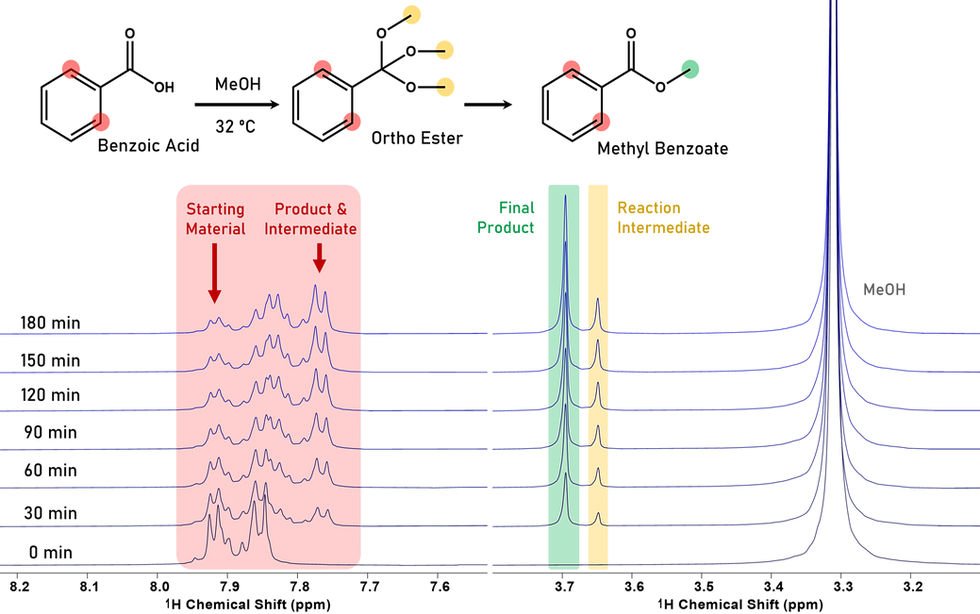If you have ever wanted the ability to run and automate NMR directly in your own lab or follow a reaction as it unfolds, check out our application note which demonstrates use of the QM-125 to monitor a Fischer esterification reaction. Using QM Control together with a short Python script, the instrument automatically collected spectra every five minutes during a three-hour Fischer esterification of benzoic acid, all performed in methanol. The combination of automated sampling and the built-in flow path of the QM-125 allows the reaction to be viewed step by step through changes in peak integrals for the starting material, intermediate species, and final product. In this reaction, we spot the ortho-ester reaction intermediate as the reaction progresses towards the final product.

Tracking the progress of a Fischer esterification reaction of benzoic acid in methanol by benchtop NMR at 125 MHz over the course of three hours.
The same flow-ready design makes the QM-125 ready to handle a wide range of customized and hyphenated setups. Whether your workflow is straightforward or complex, it can be automated to collect data at any time-intervals defined by the user. In addition, the QM-125 does not require deuterated solvents and provides consistent field uniformity, which is desired when comparing data at various time points. The application note offers an use case of how automated NMR can be added to modern flow chemistry, process optimization, and other research environments that depend on steady, informative analytical feedback. Most importantly, it shows how chemists can bring NMR directly into their own workflow and let the instrument adapt to their chemistry.
Click the link above to get this application note and learn more about how the QM-125 can be integrated into your lab.
Updated: Oct 27
The QM-125 benchtop NMR represents a new generation of analytical instrumentation built around flexibility, automation, and simplicity. With its 3-Tesla magnet and 125 MHz Larmor frequency, it delivers the highest field strength in its class while introducing a versatile approach to NMR sample handling: sample-delivery-by-flow. NMR samples can be introduced by syringe and from on-line and in-line automated delivery systems. The versatility of flow-NMR can change the way you think about routine sample handling and high-throughput NMR applications.
Inside the QM-125, a single piece of 100% PFA polymer tubing runs continuously through the magnet from one front-panel fluid fitting to the other, forming an easily replaced and chemically inert flow path. Due to the low surface adhesion of the PFA tubing, liquid samples are easily displaced with air or flushed with solvent to clear the tube for the next sample. For high-precision applications, the sample tube may also be easily washed with µL amounts of the following sample as a sacrificial volume to prepare the tube for measurement. Either way, the sample tube can be reused indefinitely without risk of carryover or contamination with best practices.
Sample tube have a long lifetime however, as every chemist knows, experiments don’t always go as planned when pushing the boundaries of chemistry. Every now and then, a challenging sample or unexpected reaction mixture may make its way into the flow path. That’s why the QM-125 is designed with practicality in mind, so that replacing the sample tube is quick, inexpensive, and user-manageable.
To better understand the sample tube design of the QM-125, check out our recent video, which provides a step-by-step look at how the flow path works and demonstrates how easy it is to replace the sample tube in just a few minutes. The video offers a view inside the instrument and shows how the practical and user-friendly design of sample-delivery-by-flow makes the QM-125 ready for walk-up use and for your automated applications.
With its seamless flow-NMR operation, compact footprint, and hyphenation capabilities, benchtop NMR is becoming more accessible to all NMR users. The design of the QM-125 sets a new standard for benchtop NMR flexibility, paving the way for the next generation of automated, connected, and high-performance NMR applications.
- Tyler Ozvat

Updated: Oct 22
Welcome to our latest video tutorial on sample injection instructions using the QM-125 benchtop NMR spectrometer from Q Magnetics. Whether you're a chemistry enthusiast, a researcher, or a student, we'll guide you through a step-by-step process of sample injection, providing you best practices for loading NMR sample when using the QM-125.
Here's a breakdown of the sample injection tutorial:
Open the flow path by removing the caps from the inlet and outlet port. When the instrument is not in use, keep the flow path enclosed with the caps.
Start by securing the stainless-steel syringe port to the inlet.
Secure the drain tube to the outlet. The entire volume of the flow-path inside the instrument is 360 microliters.
Draw sample with a 1 mL syringe and blunt-tip needle.
Inject the sample via the syringe port. If the sample contains suspended solids or undissolved material, use a syringe filter while injecting.
Before removing the syringe, first remove the drain tube and close the end of the flow path with a port cap.
Now remove the syringe and injection port, and close the front of the flow path to contain the sample for measurement.
This tutorial demonstrates how easy and convenient sample injection is with the QM-125 benchtop NMR. Stay tuned for more informative tutorials on NMR spectroscopy with the QM-125 from Q Magnetics.






